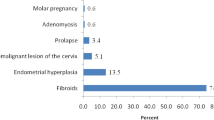Abstract
Background
Potential risks associated with using a laparoscopic power morcellator have been reported in terms of the intraperitoneal seeding of benign and malignant diseases; therefore, knowing the precise incidence of unexpected uterine malignancy (UUM) would have clinically significant value.
Objective
The aim of this study was to investigate the incidence of UUM after a hysterectomy for benign conditions.
Methods
We analyzed the national inpatient sample data that were extracted by a stratified random sampling (sex and age) method from the Korean National Health Insurance Database between 1 January 2010 and 31 December 2012.
Results
Among 1,878,507 women treated during the study period, 12,850 women who underwent a hysterectomy for benign conditions were enrolled in this study. The mean age of these women was 47.22 ± 7.07 years. A laparotomic or laparoscopic hysterectomy was performed in 6623 and 6227 women, respectively, and UUM after hysterectomy was diagnosed in 24 women. No significant difference in the incidence of UUM was noted between the laparotomic and laparoscopic cases [laparotomy, 15 (0.23 %); laparoscopy, 9 (0.14 %); p = 0.28]. The incidence of UUM after hysterectomy was 0.19 % [confidence interval (CI) 0.11–0.26 %]; the incidence of unsuspected endometrial cancer after hysterectomy was 0.12 % (CI 0.06–0.19 %); and the incidence of UUM other than endometrial cancer after hysterectomy was 0.06 % (CI 0.02–0.11 %).
Conclusion
This study shows that the incidence of UUM diagnosed after a hysterectomy for benign conditions was low, but has clinical significance with regard to the potential dissemination of UUM.
Similar content being viewed by others
References
Steiner RA, Wight E, Tadir Y, Haller U. Electrical cutting device for laparoscopic removal of tissue from the abdominal cavity. Obstet Gynecol. 1993;81:471-4.
Hampton T. Critics of fibroid removal procedure question risks it may pose for women with undetected uterine cancer. JAMA. 2014;311:891-3.
Milad MP, Milad EA. Laparoscopic morcellator-related complications. J Minim Invasive Gynecol. 2014;21:486-91.
Health C for D and R. Safety communications - UPDATED laparoscopic uterine power morcellation in hysterectomy and myomectomy: FDA safety communication. 2015. Available from http://www.fda.gov/medicaldevices/safety/alertsandnotices/ucm424443.htm.
Yuk JS, Ji HY, Lee SH, Park YS, Lee JH. Unexpected uterine malignancy in women who have undergone myomectomy. Int J Gynaecol Obstet. 2015;129:270-1.
Yuk J-S, Ji HY, Shin J-Y, Kim LY, Kim S-H, Lee JH. Comparison of survival outcomes in women with unsuspected uterine malignancy diagnosed after laparotomic versus laparoscopic myomectomy: a national, population-based study. Ann Surg Oncol. 2015:1-7.
Kim L, Kim JA, Kim S. A guide for the utilization of Health Insurance Review and Assessment Service National Patient Samples. Epidemiol Health. 2014;36:e2014008.
Yuk JS, Kim YJ, Yi KW, Tak K, Hur JY, Shin JH. High rate of nickel allergy in women with endometriosis: a 3‐year population‐based study. J Obstet Gynaecol Res. 2015;41:1255-9.
Wright JD, Tergas AI, Burke WM, et al. Uterine pathology in women undergoing minimally invasive hysterectomy using morcellation. JAMA. 2014;312:1253-5.
Gomez SL, Noone AM, Lichtensztajn DY, et al. Cancer incidence trends among Asian American populations in the United States, 1990-2008. J Natl Cancer Inst. 2013;105:1096-110.
Ramm O, Gleason JL, Segal S, Antosh DD, Kenton KS. Utility of preoperative endometrial assessment in asymptomatic women undergoing hysterectomy for pelvic floor dysfunction. Int Urogynecol J. 2012;23:913-7.
Sinha R, Hegde A, Mahajan C, Dubey N, Sundaram M. Laparoscopic myomectomy: do size, number, and location of the myomas form limiting factors for laparoscopic myomectomy? J Minim Invasive Gynecol. 2008;15:292-300.
Brohl AS, Li L, Andikyan V, et al. Age-stratified risk of unexpected uterine sarcoma following surgery for presumed benign leiomyoma. Oncologist. 2015;20:433-9.
Parker WH, Fu YS, Berek JS. Uterine sarcoma in patients operated on for presumed leiomyoma and rapidly growing leiomyoma. Obstet Gynecol. 1994;83:414-8.
Seidman MA, Oduyebo T, Muto MG, Crum CP, Nucci MR, Quade BJ. Peritoneal dissemination complicating morcellation of uterine mesenchymal neoplasms. PLoS One. 2012;7:e50058.
Leibsohn S, d’Ablaing G, Mishell DR Jr, Schlaerth JB. Leiomyosarcoma in a series of hysterectomies performed for presumed uterine leiomyomas. Am J Obstet Gynecol. 1990;162:968-74; discussion 74-6.
Takamizawa S, Minakami H, Usui R, et al. Risk of complications and uterine malignancies in women undergoing hysterectomy for presumed benign leiomyomas. Gynecol Obstet Invest. 1999;48:193-6.
Kamikabeya TS, Etchebehere RM, Nomelini RS, Murta EF. Gynecological malignant neoplasias diagnosed after hysterectomy performed for leiomyoma in a university hospital. Eur J Gynaecol Oncol. 2010;31:651-3.
Leung F, Terzibachian JJ, Gay C, et al. Hysterectomies performed for presumed leiomyomas: should the fear of leiomyosarcoma make us apprehend non laparotomic surgical routes? [in French]. Gynecol Obstet Fertil. 2009;37:109-14.
Mahajan G, Kotru M, Batra M, Gupta A, Sharma S. Usefulness of histopathological examination in uterine prolapse specimens. Aust N Z J Obstet Gynaecol. 2011;51:403-5.
Rowland M, Lesnock J, Edwards R, et al. Occult uterine cancer in patients undergoing laparoscopic hysterectomy with morcellation: implications for surveillance for disease recurrence and outcomes. Gynecol Oncol. 2013;130:e77.
Wan OY, Cheung RY, Chan SS, Chung TK. Risk of malignancy in women who underwent hysterectomy for uterine prolapse. Aust N Z J Obstet Gynaecol. 2013;53:190-6.
Theben JU, Schellong AR, Altgassen C, Kelling K, Schneider S, Grosse-Drieling D. Unexpected malignancies after laparoscopic-assisted supracervical hysterectomies (LASH): an analysis of 1,584 LASH cases. Arch Gynecol Obstet. 2013;287:455-62.
Ouldamer L, Rossard L, Arbion F, Marret H, Body G. Risk of incidental finding of endometrial cancer at the time of hysterectomy for benign condition. J Minim Invasive Gynecol. 2014;21:131-5.
Mahnert N, Morgan D, Campbell D, Johnston C, As-Sanie S. Unexpected gynecologic malignancy diagnosed after hysterectomy performed for benign indications. Obstet Gynecol. 2015;125:397-405.
Funding
This article was not supported by any financial funds, and the authors are not affiliated with the instrumental company referred to in the text.
Conflicts of Interest
Jin-Sung Yuk, Log Young Kim, Sang-Hyun Kim, and Jung Hun Lee report no conflicts of interest.
Author information
Authors and Affiliations
Corresponding author
Rights and permissions
About this article
Cite this article
Yuk, JS., Kim, L.Y., Kim, SH. et al. The Incidence of Unexpected Uterine Malignancy in Women Undergoing Hysterectomy for a Benign Condition: A National Population-Based Study. Ann Surg Oncol 23, 4029–4034 (2016). https://doi.org/10.1245/s10434-016-5287-z
Received:
Published:
Issue Date:
DOI: https://doi.org/10.1245/s10434-016-5287-z



